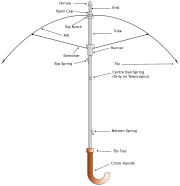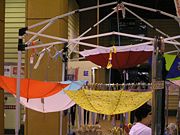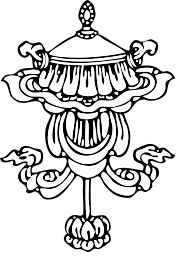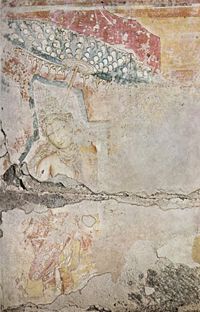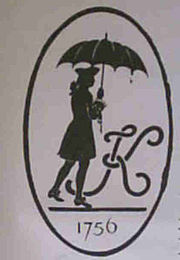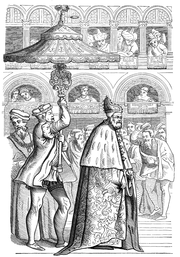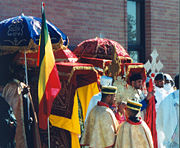Umbrella
2008/9 Schools Wikipedia Selection. Related subjects: Everyday life

Traditional umbrella shop in London
|

Parasols in Wuhan, China
|
An umbrella or parasol (sometimes colloquially, gamp, brolly, or bumbershoot) is a canopy designed to protect against precipitation or sunlight. The term parasol usually refers to an item designed to protect from the sun, and umbrella refers to a device more suited to protect from rain. Often the difference is the material; some parasols are not waterproof. Parasols are often meant to be fixed to one point and often used with patio tables or other outdoor furniture, or on the beach for shelter from the sun. Umbrellas are almost exclusively hand-held portable devices; however, parasols can also be hand-held. Umbrellas can be held as fashion statements in the twenty first century for some men and women and are sometimes seen as simple accessories that complete an outfit.
The word umbrella is from the Latin word umbra, which in turn derives from the Ancient Greek ómbros (όμβρος). Its meaning is shade or shadow. Brolly is a slang word for umbrella, used often in Britain, New Zealand and Australia. Bumbershoot is a fanciful Americanism from the late 19th century.
Derivation
Umbrella is another synonym for the term parasol, which was first used as a protection against the scorching heat of the sun, "para" meaning stop or shield and "sol" meaning sun. The word "umbrella" has evolved from the Latin "umbella" (and "umbel" is a flat-topped rounded flower) or "umbra," meaning "shaded." In Britain, umbrellas are sometimes called "gamps" after the character Mrs Gamp in the Charles Dickens novel, Martin Chuzzlewit, who was known for often carrying an umbrella.
History
Middle East
In the sculptures at Nineveh the parasol appears frequently. Austen Henry Layard gives a picture of a bas-relief representing a king in his chariot, with an attendant holding a parasol over his head. It has a curtain hanging down behind, but is otherwise exactly like those in use today. It is reserved exclusively for the monarch, and is never carried over any other person.
In Persia the parasol is repeatedly found in the carved work of Persepolis, and Sir John Malcolm has an article on the subject in his 1815 "History of Persia." In some sculptures, the figure of a king appears attended by a slave, who carries over his head an umbrella, with stretchers and runner complete. In other sculptures on the rock at Takht-i-Bostan, supposed to be not less than twelve centuries old, a deer-hunt is represented, at which a king looks on, seated on a horse, and having an umbrella borne over his head by an attendant.
Ancient Egypt
In Egypt again, the parasol is found in various shapes. In some instances it is depicted as a flaellum, a fan of palm-leaves or coloured feathers fixed on a long handle, resembling those now carried behind the Pope in processions. Gardiner Wilkinson, in his work on Egypt, has an engraving of an Ethiopian princess travelling through Upper Egypt in a chariot; a kind of umbrella fastened to a stout pole rises in the centre, bearing a close affinity to what are now termed chaise umbrellas. According to Wilkinson's account, the umbrella was generally used throughout Egypt, partly as a mark of distinction, but more on account of its useful than its ornamental qualities. In some paintings on a temple wall, a parasol is held over the figure of a god carried in procession.
Ancient Greece
In Greece, the parasol was an indispensable adjunct to a lady of fashion. It had also its religious signification. In the Scirophoria, the feast of Athene Sciras, a white parasol was borne by the priestesses of the goddess from the Acropolis to the Phalerus. In the feasts of Dionysius the Umbrella was used, and in an old bas-relief the same god is represented as descending ad inferos with a small Umbrella in his hand.
In the Panathenæa, the daughters of the Metceci, or foreign residents, carried Parasols over the heads of Athenian women as a mark of inferiority. Its use seems to have been confined to women. In Pausanias, lib. vii., cap. 22, Section 6. there is a description of a tomb near Pharæ, a Greek city. On the tomb was the figure of a woman, "and by her stood a female slave, bearing a parasol". For a man to carry one was considered a mark of effeminacy (Anacreon, Athenaeus, lib. xii., cap. 46, Section 534.).
In addition, Aristophanes seems to mention it among the common articles of female use ( Thesmophoriazusae 821).
Ancient Rome
From Greece it is probable that the use of the parasol passed to Rome, where it seems to have been commonly used by women, while it was the custom even for effeminate men to defend themselves from the heat by means of the Umbraculum, formed of skin or leather, and capable of being lowered at will. There are frequent references to the Umbrella in the Roman Classics, and it appears that it was, not unlikely, a post of honour among maid-servants to bear it over their mistresses. Allusions to it are tolerably frequent in the poets. ( Ovid Fast. lib. ii., 1. 31 I.; Martial, lib. xi., ch. 73.; lib. xiv, ch. 28, 130; Juvenal, ix., 50.; Ovid Ars. Am., ii., 209). From such mentions the Umbrella does not appear to have been used as a defence from rain; this is curious enough, for it is known that the theatres were protected by the velarium or awning, which was drawn across the arena whenever a sudden shower came on. Possibly the expense bestowed in the decoration of the umbraculum was a reason for its not being applied to such use.
According to Gorius, the umbrella came to Rome from the Etruscans, and certainly it appears not infrequently on Etruscan vases, as also on later gems. One gem, figured by Pacudius, shows an Umbrella with a bent handle, sloping backwards. Strabo describes a sort of screen or Umbrella worn by Spanish women, but this is not like a modern Umbrella.
Very many curious facts are connected with the use of the Umbrella throughout the East, where it was nearly everywhere one of the insignia of royalty, or at least of high rank.
China
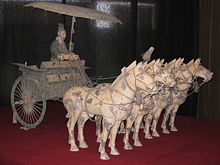
In written records, the oldest reference to a collapsible umbrella dates to the year 21 A.D., when Wang Mang (r. 9–23) had one designed for a ceremonial four-wheeled carriage. Although sun shades were used by the Babylonians, Greeks, and Romans, their umbrellas and parasols did not feature mechanical sliding levers that would make them collapsible. The 2nd century commentator Fu Qian added that this collapsible umbrella of Wang Mang's carriage had bendable joints which enabled them to be extended or retracted. A 1st century collapsible umbrella has since been recovered from the tomb of Wang Guang at the Korean site of the Lelang Commandery, illustrated in a work by Harada and Komai. However, the Chinese collapsible umbrella is perhaps a concept that is yet centuries older than Qin's tomb. Zhou Dynasty bronze castings of complex bronze socketed hinges with locking slides and bolts—which could have been used for parasols and umbrellas— were found in an archeological site of Luoyang, dated to the 6th century BCE.
An even older source on the umbrella is perhaps the ancient book of Chinese ceremonies, called Zhou Li (The Rites of Zhou), dating 2400 years ago, which directs that upon the imperial cars the dais should be placed. The figure of this dais contained in Zhou-Li, and the description of it given in the explanatory commentary of Lin-hi-ye, both identify it with an umbrella. The latter describes the dais to be composed of 28 arcs, which are equivalent to the ribs of the modern instrument, and the staff supporting the covering to consist of two parts, the upper being a rod 3/18 of a Chinese foot in circumference, and the lower a tube 6/10 in circumference, into which the upper half is capable of sliding and closing.
The Chinese character for umbrella is 傘 (sǎn) and is a pictograph resembling the modern umbrella in design. Some investigators have supposed that its invention was first created by tying large leaves to bough-like ribs (the branching out parts of an umbrella). Others assert that the idea was probably derived from the tent, which remains in form unaltered to the present day. However, the tradition existing in China is that it originated in standards and banners waving in the air, hence the use of the umbrella was often linked to high ranking (though not necessarily royalty in China). On one occasion at least, twenty-four umbrellas were carried before the Emperor when he went out hunting. In this case the umbrella served as a defense against rain rather than sun. The Chinese design was later brought to Japan via Korea and also introduced to Persia and the Western world via the Silk Road. The Chinese and Japanese traditional parasol, often used near temples, to this day remains similar to the original ancient Chinese design.
A late Song Dynasty Chinese divination book that was printed in about 1270 CE features a picture of a collapsible umbrella that is exactly like the modern umbrella of today's China.
Indian subcontinent
The Sanscrit epic Mahabharata (about 4th century) relates the following legend: Jamadagni was a skilled bow shooter, and his devoted wife Renuka would always recover each of his arrows immediately. One time however, it took her a whole day to fetch a bow, and she later blamed the heat of the sun for the delay. The angry Jamadagni shot an arrow at the sun. The sun begged for mercy and offered Renuka an umbrella.
Jean Baptiste Tavernier, in his 17th century book "Voyage to the East," says that on each side of the Mogul's throne were two umbrellas, and also describes the hall of the King of Ava as decorated with an umbrella. The Maratha princes, who reigned at Poona and Sattara, had the title of Ch'hatra-pati, "Lord of the Umbrella." The cháta of the Indian and Burmese princes is large and heavy, and requires a special attendant, who has a regular position in the royal household. In Ava it seems to have been part of the king's title, that he was "King of the white elephant, and Lord of the twenty-four Umbrellas." Persons of rank in the Mahratha court, who were not permitted the right of carrying an Umbrella, used a screen, a flat vertical disc called AA'-ab-gir, carried by an attendant. In 1855 the King of Burma directed a letter to the Marquis of Dalhousie in which he styles himself "His great, glorious, and most excellent Majesty, who reigns over the kingdoms of Thunaparanta, Tampadipa, and all the great Umbrella-wearing chiefs of the Eastern countries".
Siam
Simon de la Loubère, who was Envoy Extraordinary from the French King to the King of Siam in 1687 and 1688, wrote an account entitled a "New Historical Relation of the Kingdom of Siam," which was translated in 1693 into English. According to his account the use of the umbrella was granted to only some of the subjects by the king. An umbrella with several circles, as if two or three umbrellas were fastened on the same stick, was permitted to the king alone, the nobles carried a single umbrella with painted cloths hanging from it. The Talapoins (who seem to have been a sort of Siamese monks) had umbrellas made of a palm-leaf cut and folded, so that the stem formed a handle.
Europe
The extreme paucity of allusions to umbrellas throughout the Middle Ages shows that they were not in common use. In an old romance, "The Blonde of Oxford", a jester makes fun of a nobleman for being out in the rain without his cloak. "Were I a rich man," says he, "I would bear my house about with me." It appears that people depended on cloaks, not umbrellas, for protection against storms.
17th century
Thomas Wright, in his "Domestic Manners of the English," gives a drawing from the Harleian MS., No. 604, which represents an Anglo-Saxon gentleman walking out attended by his servant, the servant carrying an umbrella with a handle that slopes backwards, so as to bring the umbrella over the head of the person in front. It probably could not be closed, but otherwise it looks like an ordinary umbrella, and the ribs are represented distinctly.
The general use of the parasol in France and England was adopted, probably from China, about the middle of the seventeenth century. At that period, pictorial representations of it are frequently found, some of which exhibit the peculiar broad and deep canopy belonging to the large parasol of the Chinese Government officials, borne by native attendants.
John Evelyn, in his Diary for 22 June 1664, mentions a collection of rarities shown him by one Thompson, a Roman Catholic priest, sent by the Jesuits of Japan and China to France. Among the curiosities were "fans like those our ladies use, but much larger, and with long handles, strangely carved and filled with Chinese characters," which is evidently a description of the parasol.
In Thomas Coryat's " Crudities," a very rare and highly interesting work, published in 1611, about a century and a half prior to the general introduction of the umbrella into England, is a curious reference to a custom of riders in Italy using umbrellas:--
- "And many of them doe carry other fine things of a far greater price, that will cost at the least a duckat, which they commonly call in the Italian tongue umbrellas, that is, things which minister shadowve to them for shelter against the scorching heate of the sunne. These are made of leather, something answerable to the forme of a little cannopy, & hooped in the inside with divers little wooden hoopes that extend the umbrella in a pretty large compasse. They are used especially by horsemen, who carry them in their hands when they ride, fastening the end of the handle upon one of their thighs, and they impart so large a shadow unto them, that it keepeth the heate of the sunne from the upper parts of their bodies."
In John Florio's "A WORLD of Words" (1598), the Italian word Ombrella is translated
- "a fan, a canopie. also a testern or cloth of state for a prince. also a kind of round fan or shadowing that they vse to ride with in sommer in Italy, a little shade. Also a bonegrace for a woman. Also the husk or cod of any seede or corne. also a broad spreding bunch, as of fenell, nill, or elder bloomes."
In Randle Cotgrave's "Dictionary of the French and English Tongues" (1614), the French Ombrelle is translated
- "An umbrello; a (fashion of) round and broad fanne, wherewith the Indians (and from them our great ones) preserve themselves from the heat of a scorching sunne; and hence any little shadow, fanne, or thing, wherewith women hide their faces fro the sunne."
In Fynes Moryson's "Itinerary" (1617) is a similar allusion to the habit of carrying umbrellas in hot countries "to auoide the beames of the sunne." Their employment, says the author, is dangerous, "because they gather the heate into a pyramidall point, and thence cast it down perpendicularly upon the head, except they know how to carry them for auoyding that danger."
18th and 19th centuries
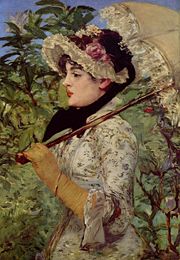
Kersey's Dictionary (1708) describes an umbrella as a "screen commonly used by women to keep off rain."
Daniel Defoe's Robinson Crusoe constructs his own umbrella in imitation of the ones he had seen used in Brazil. "I covered it with skins," he says, "the hair outwards, so that it cast off the rain like a pent-house, and kept off the sun so effectually, that I could walk out in the hottest of the weather with greater advantage than I could before in the coolest." From this description the original heavy umbrellas obtained the name of "Robinson," which they retained for many years, both in England and France.
Captain James Cook, in one of his voyages, sees some of the natives of the South Pacific Islands, with umbrellas made of palm leaves.
That the use of the umbrella or parasol—though not unknown—was not very common during the earlier half of the eighteenth century, is evident from the fact that General (then Lieut.-Colonel) James Wolfe, writing from Paris in 1752, speaks of the people there using umbrellas for the sun and rain, and wonders that a similar practice does not obtain in England. Just about the same time they seem to have come into general use, and that pretty rapidly, as people found their value, and got over the shyness natural to a first introduction. Jonas Hanway, the founder of the Magdalen Hospital, has the credit of being the first man who ventured to dare public reproach and ridicule by carrying one habitually in London. As he died in 1786, and he is said to have carried an umbrella for thirty years, the date of its first use by him may be set down at about 1750. John Macdonald relates that in 1770, he used to be greeted with the shout, "Frenchman, Frenchman! why don't you call a coach?" whenever he went out with his umbrella.
Since this date, however, the umbrella has come into general use, and in consequence numerous improvements have been effected in it. The transition to the present portable form is due, partly to the substitution of silk and gingham for the heavy and troublesome oiled silk, which admitted of the ribs and frames being made much lighter, and also to many ingenious mechanical improvements in the framework. Victorian era umbrellas had frames of wood or baleen, but these devices were expensive and hard to fold when wet. Samuel Fox invented the steel-ribbed umbrella in 1852; however, the Encyclopédie Méthodique mentions metal ribs at the end of the eighteenth century. Modern designs usually employ a telescoping steel trunk. New materials such as cotton, plastic film and nylon often replace the original silk. They now are available in compact collapsible designs.
Ecclesiastical use
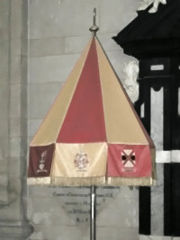
As a canopy of state, umbrellas were generally used in southern and eastern Europe, and then passed by a natural process from the imperial court into church ceremonial. They are found in the ceremonies of the Byzantine Church, they were borne over the Host in procession, and form part of the Pontifical regalia. Consequently, the ombrellino or umbraculum, is a part of the papal regalia. Although the popes no longer use it personally, it is displayed on the coat of arms of a sede vacante (the papal arms used between the death of a pope and the election of his successor). This umbraculum is normally made of alternating red and gold fabric, and is usually displayed in a partially unfolded manner. The popes have traditionally bestowed the use of the umbraculum as a mark of honour upon specific persons and places. The use of an umbraculum is one of the honarary symbols of a basilica and may be used in the basilica's coat of arms, and carried in processions by the basilica's canons.
A medieval gem portrays a bishop, attended by a cross-bearer, and a servant who carries behind him an umbrella.
A large umbrella is displayed in each of the Basilicas of Rome, and a cardinal bishop who receives his title from one of those churches has the privilege of having an umbrella carried over his head in solemn processions. It is possible that the galero (wide-brimmed cardinal's hat) may be derived from this umbrella. Beatiano, an Italian herald, says that "a vermilion umbrella in a field argent symbolises dominion."
In several Oriental Orthodox Churches, such as the Ethiopian Orthodox Tewahedo Church, umbrellas are used liturgically to show honour to a person (such as a bishop) or a holy object. In the ceremonies of Timkat (Epiphany), priests will cary a model of the Ark of the Covenant, called a Tabot, on their heads in procession to a body of water, which will then be blessed. Brightly-colored embroidered and fringed liturgical parasols are carried above the Tabota during this procession. Such processions also take place on other major feast days.
In photography
An umbrella is a valuable tool for photographers, both as a prop when photographing subjects in inclement weather or, with a reflective inside, as a diffusion device when employing artificial lighting, most often in portrait situations.
